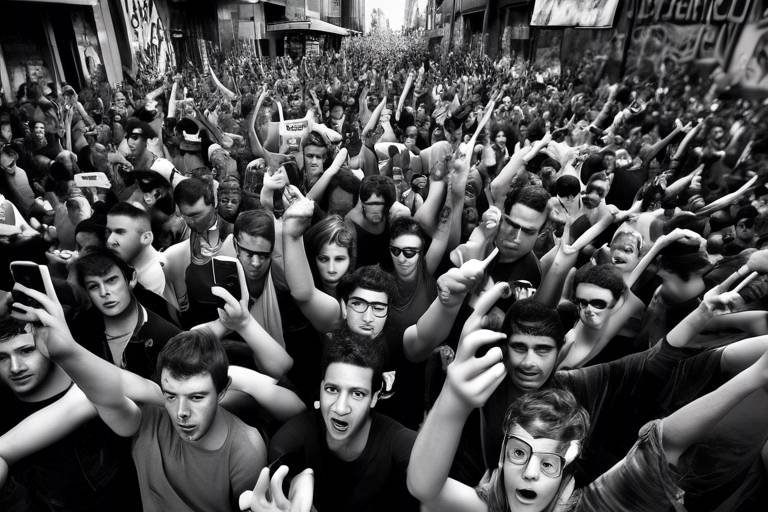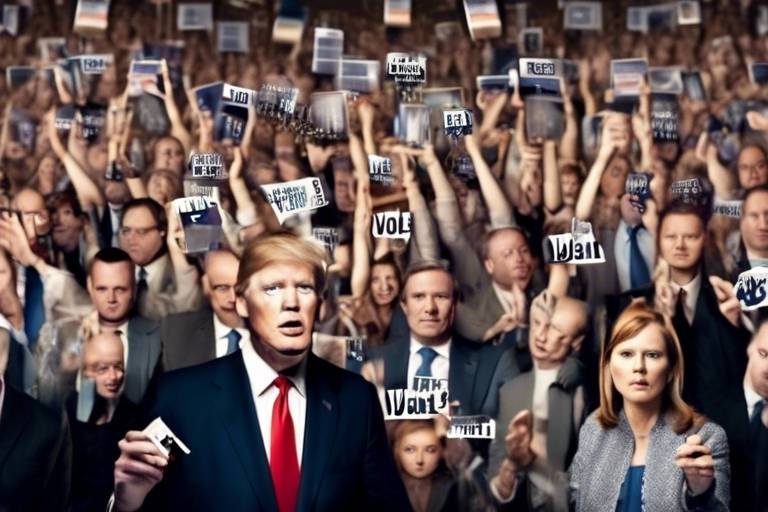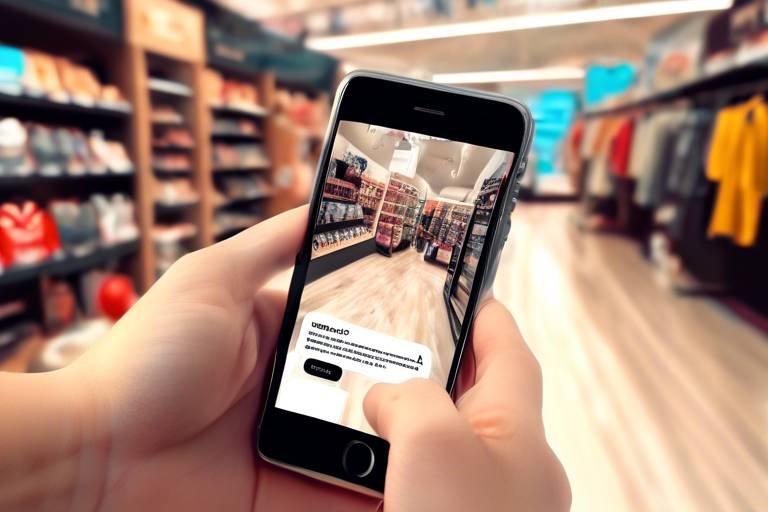The Effects of Social Media on Knowledge Sharing
In today's digital age, social media has become a cornerstone for how we connect, communicate, and share knowledge. It's fascinating to think about how platforms like Facebook, Twitter, LinkedIn, and Instagram have transformed the landscape of information dissemination. No longer are we confined to traditional methods of sharing knowledge, such as books or lectures; instead, we have the world at our fingertips, allowing us to exchange ideas and insights in real-time. But what does this mean for the quality and reliability of the information we consume? In this article, we will delve into the multifaceted effects of social media on knowledge sharing, exploring both the positive and negative impacts it has on our ability to learn and collaborate.
Social media platforms serve as vital tools for knowledge sharing, enabling users to connect, collaborate, and exchange information seamlessly across geographical boundaries. Imagine a world where a student in a small town can interact with industry experts halfway across the globe. This is the reality that social media creates. With just a few clicks, users can join discussions, participate in webinars, and access a wealth of information that was previously out of reach. The interactivity of these platforms fosters a sense of community and belonging, encouraging individuals to share their insights and experiences. It's like being in a giant classroom where everyone is both a teacher and a student, contributing to a collective pool of knowledge.
Engagement on social media fosters a dynamic environment for knowledge sharing, where users actively participate in discussions, share insights, and contribute to collective learning. The beauty of social media lies in its ability to facilitate interaction. Users are not just passive consumers of information; they are active participants. This engagement can take many forms, from commenting on posts and sharing articles to joining groups focused on specific interests. The more engaged users are, the more knowledge is shared. It's similar to a lively marketplace where ideas are exchanged, debated, and refined, leading to richer understanding and innovation.
Visual content, such as infographics and videos, enhances knowledge sharing on social media by making information more accessible and engaging for diverse audiences. In a world where attention spans are shrinking, visuals can capture interest and convey complex ideas quickly. For instance, an infographic summarizing a lengthy research paper can be far more effective than the paper itself. This is because visuals appeal to our innate preference for storytelling; they simplify information and make it digestible. However, while visuals can enhance understanding, they also necessitate critical thinking. Users must discern which visuals are informative and which are misleading.
Multimedia elements can significantly improve understanding and retention of information, making learning experiences more effective and enjoyable for users. Studies have shown that incorporating various forms of media—like videos, podcasts, and interactive quizzes—can cater to different learning styles. This diversity in content can transform a mundane learning experience into an engaging adventure. Think of it as a buffet of knowledge, where everyone can find something that appeals to their taste. However, it’s essential to recognize that not all multimedia content is created equal; quality matters immensely.
The abundance of visual content can lead to information overload, making it difficult for users to discern valuable knowledge from noise. In a world overflowing with data, users often find themselves overwhelmed by the sheer volume of information available. This can lead to decision fatigue, where individuals struggle to make sense of what is relevant. It’s like trying to find a needle in a haystack—frustrating and time-consuming. Users must develop skills to filter through the noise, focusing on credible sources while avoiding sensationalism.
Social media facilitates the creation of communities where individuals with shared interests can collaborate, share knowledge, and support each other's learning journeys. These communities, often referred to as "communities of practice," provide a platform for users to connect over common goals. Whether it’s a Facebook group for budding entrepreneurs or a Twitter chat for educators, these spaces encourage collaboration and innovation. The synergy created within these communities can lead to groundbreaking ideas and solutions, as members draw on each other’s expertise and experiences.
Despite its benefits, social media presents challenges such as misinformation, lack of credibility, and privacy concerns, which can hinder effective knowledge sharing. The rapid spread of information can sometimes blur the lines between fact and fiction, leading to the dissemination of false information. Users must be vigilant, questioning the credibility of sources before accepting information as truth. This critical evaluation is essential in maintaining the integrity of knowledge shared on social media.
Combating misinformation is crucial for ensuring that knowledge shared on social media is accurate and reliable, requiring users to critically evaluate sources. It’s imperative that users become savvy consumers of information, asking questions like: Who is the author? What are their credentials? Is the information supported by evidence? Just as we wouldn’t buy a car without checking its history, we shouldn’t accept information without examining its source.
Privacy issues arise when sharing personal knowledge online, necessitating a discussion about ethical practices and the responsibilities of users in digital spaces. The line between public and private can often become blurred on social media, leading to potential risks. Users must be aware of what they share and how it may impact their privacy. Moreover, ethical considerations should guide how knowledge is shared, ensuring that individuals respect the intellectual property of others while contributing to the collective learning environment.
- How does social media improve knowledge sharing? Social media enhances knowledge sharing by connecting individuals across the globe, allowing for real-time discussions and the exchange of diverse ideas.
- What are some challenges of using social media for knowledge sharing? Challenges include misinformation, information overload, and privacy concerns.
- How can I ensure the information I share on social media is credible? Always verify the source of information and cross-check with reputable platforms before sharing.

The Role of Social Media Platforms
This article explores how social media influences the way knowledge is shared among individuals and communities, highlighting both positive and negative impacts on information dissemination and collaboration.
Social media platforms have revolutionized the way we communicate and share knowledge. Imagine a world where geographical boundaries no longer restrict the flow of information; that's precisely what social media has accomplished. These platforms act as bridges, connecting individuals from diverse backgrounds and facilitating the exchange of ideas, insights, and experiences. Whether it's through a simple tweet, a Facebook post, or a LinkedIn article, users can disseminate information quickly and efficiently, reaching audiences they might never have encountered otherwise.
One of the most significant roles that social media plays in knowledge sharing is its ability to foster collaboration. Users can easily form groups or communities centered around specific interests or fields of study. For instance, professionals in a niche industry can join forums or groups on platforms like LinkedIn or Facebook to share best practices, discuss challenges, and collaborate on projects. This not only enhances individual learning but also contributes to the overall growth of knowledge within the community.
Furthermore, social media platforms provide a space for real-time interaction. Imagine attending a virtual conference where you can engage with thought leaders and peers simultaneously from the comfort of your home. This level of interaction allows for immediate feedback and discussion, making knowledge sharing a dynamic and engaging process. Users can ask questions, provide answers, and even challenge existing ideas in a way that traditional methods of knowledge dissemination simply cannot match.
However, it's essential to recognize that not all knowledge shared on social media is created equal. The ease of sharing information can lead to the spread of misinformation and unverified claims. Therefore, while social media platforms are powerful tools for knowledge sharing, they also require users to be discerning about the information they consume and share. This calls for a critical approach to evaluating sources and understanding the context of the information being presented.
In summary, social media platforms serve as vital tools for knowledge sharing by:
- Connecting individuals across geographical boundaries.
- Fostering collaboration through group interactions.
- Enabling real-time feedback and dynamic discussions.
- Encouraging diverse perspectives and ideas.
As we navigate this digital landscape, it's crucial to harness the benefits of social media while remaining vigilant about the challenges it poses. The potential for enhanced learning and collaboration is immense, but it requires a conscious effort to engage with information responsibly.
Engagement on social media fosters a dynamic environment for knowledge sharing, where users actively participate in discussions, share insights, and contribute to collective learning.
Visual content, such as infographics and videos, enhances knowledge sharing on social media by making information more accessible and engaging for diverse audiences.
Multimedia elements can significantly improve understanding and retention of information, making learning experiences more effective and enjoyable for users.
The abundance of visual content can lead to information overload, making it difficult for users to discern valuable knowledge from noise.
Social media facilitates the creation of communities where individuals with shared interests can collaborate, share knowledge, and support each other's learning journeys.
Despite its benefits, social media presents challenges such as misinformation, lack of credibility, and privacy concerns, which can hinder effective knowledge sharing.
Combating misinformation is crucial for ensuring that knowledge shared on social media is accurate and reliable, requiring users to critically evaluate sources.
Privacy issues arise when sharing personal knowledge online, necessitating a discussion about ethical practices and the responsibilities of users in digital spaces.
Q1: How can I ensure the information I share on social media is credible?
A: Always verify the source of the information, look for citations, and cross-reference with reputable sites.
Q2: What are some effective ways to engage with others on social media for knowledge sharing?
A: Participate in discussions, ask questions, share your insights, and join relevant groups or forums.
Q3: Can visual content really enhance learning?
A: Yes! Visual content can simplify complex information and make it more relatable, aiding in better comprehension and retention.

User Engagement and Interaction
When we dive into the world of social media, one of the most striking features is the incredible level of user engagement it fosters. Think about it—every time you scroll through your feed, you're not just passively consuming content; you're part of a vibrant community where ideas bounce around like a game of ping pong. This dynamic interaction is a game changer for knowledge sharing. Users are not merely spectators; they become active participants, sharing their insights, asking questions, and engaging in discussions that can lead to a deeper understanding of various topics.
Imagine a virtual roundtable where individuals from all walks of life come together to exchange ideas. This is the essence of social media engagement. Users can comment on posts, share articles, and even create their own content, all of which contribute to a rich tapestry of knowledge. The ability to like, share, and comment transforms a simple piece of information into a discussion point, sparking curiosity and encouraging others to join in. It’s like throwing a stone into a pond and watching the ripples spread outwards—each interaction creates a wave of new conversations and insights.
Moreover, the immediacy of social media allows for real-time interaction. Have you ever posted a question and received responses within minutes? This kind of instantaneous feedback loop is invaluable. It not only enhances learning but also creates a sense of community among users. You can think of it as a digital coffee shop where ideas are exchanged freely, and everyone has a voice. However, it’s essential to remember that not all voices are equally credible, which brings us to the importance of critical engagement.
To harness the full potential of user engagement, it’s crucial to cultivate a culture of critical thinking and respectful dialogue. Here are some ways users can enhance their experience:
- Ask Questions: Don't hesitate to seek clarification or deeper insights. Questions can lead to richer discussions.
- Share Wisely: When sharing content, consider the source. Is it credible? Is it accurate? Your shares influence others.
- Engage Respectfully: Acknowledge different perspectives and foster a climate of respect. Constructive criticism can lead to growth.
In essence, user engagement on social media is a double-edged sword. While it opens doors to collaborative learning and diverse perspectives, it also requires users to be discerning. The interactions we have online can shape our understanding of the world, making it essential to engage thoughtfully.
Q: How can I improve my engagement on social media?
A: To improve engagement, focus on creating quality content, asking open-ended questions, and responding to comments promptly. Building relationships is key!
Q: What should I do if I encounter misinformation?
A: Always verify the source before sharing. If you find misinformation, consider addressing it respectfully or reporting it if necessary.
Q: How can I ensure my privacy while engaging on social media?
A: Be mindful of the information you share. Adjust your privacy settings and think twice before posting personal details.

This article explores how social media influences the way knowledge is shared among individuals and communities, highlighting both positive and negative impacts on information dissemination and collaboration.
Social media platforms serve as vital tools for knowledge sharing, enabling users to connect, collaborate, and exchange information seamlessly across geographical boundaries.
Engagement on social media fosters a dynamic environment for knowledge sharing, where users actively participate in discussions, share insights, and contribute to collective learning.
In today's fast-paced digital landscape, the impact of visual content on knowledge sharing cannot be overstated. Visuals like infographics, videos, and images serve as powerful tools that capture attention and convey complex information in a digestible format. Think about it: when scrolling through your feed, which posts do you stop to engage with? More often than not, it's the ones that pop with color or feature a compelling image. This phenomenon is not just a matter of preference; it’s rooted in how our brains process information.
Studies show that visuals are processed 60,000 times faster than text. This means that a well-designed infographic can communicate a wealth of information in mere seconds, making it easier for users to grasp key concepts quickly. Moreover, visuals can evoke emotions and create connections that text alone often fails to achieve. For example, a short video demonstrating a product or a process can leave a lasting impression, while a lengthy article might be skimmed or overlooked entirely.
Furthermore, the use of multimedia in knowledge sharing can enhance the learning experience in several ways:
- Accessibility: Visual content breaks down language barriers, allowing individuals from diverse backgrounds to understand and engage with the material.
- Retention: People tend to remember information presented visually better than text, leading to improved knowledge retention.
- Engagement: Interactive elements, like quizzes or polls embedded in videos, can encourage users to participate actively, making learning more engaging.
However, it's essential to recognize that while visual content can enhance knowledge sharing, it also comes with its challenges. The sheer volume of visual information available online can lead to information overload. Users may find it increasingly difficult to sift through countless images and videos to identify credible sources of knowledge. This saturation can dilute the impact of genuinely valuable content, making it hard for users to discern what is worth their time and attention.
In summary, the impact of visual content on knowledge sharing is profound and multifaceted. By leveraging the strengths of visuals, social media can facilitate more effective communication and engagement, ultimately enriching the learning experience. However, as with any tool, it is crucial to approach visual content thoughtfully to avoid the pitfalls of over-saturation and misinformation.
Multimedia elements can significantly improve understanding and retention of information, making learning experiences more effective and enjoyable for users.
The abundance of visual content can lead to information overload, making it difficult for users to discern valuable knowledge from noise.
Social media facilitates the creation of communities where individuals with shared interests can collaborate, share knowledge, and support each other's learning journeys.
Despite its benefits, social media presents challenges such as misinformation, lack of credibility, and privacy concerns, which can hinder effective knowledge sharing.
Combating misinformation is crucial for ensuring that knowledge shared on social media is accurate and reliable, requiring users to critically evaluate sources.
Privacy issues arise when sharing personal knowledge online, necessitating a discussion about ethical practices and the responsibilities of users in digital spaces.
- How does visual content enhance knowledge sharing? Visual content simplifies complex information, making it easier to understand and remember.
- What are the risks associated with sharing knowledge on social media? Risks include misinformation, privacy concerns, and the potential for information overload.
- How can users ensure the credibility of the information they share? Users should critically evaluate sources and cross-check information against reputable references.

Benefits of Multimedia in Learning
This article explores how social media influences the way knowledge is shared among individuals and communities, highlighting both positive and negative impacts on information dissemination and collaboration.
Social media platforms serve as vital tools for knowledge sharing, enabling users to connect, collaborate, and exchange information seamlessly across geographical boundaries.
Engagement on social media fosters a dynamic environment for knowledge sharing, where users actively participate in discussions, share insights, and contribute to collective learning.
Visual content, such as infographics and videos, enhances knowledge sharing on social media by making information more accessible and engaging for diverse audiences.
When it comes to learning, multimedia is like a secret sauce that can make the experience not just informative but also enjoyable. Imagine trying to learn a new concept through a dry textbook versus watching a vibrant video that brings the topic to life. Which one would you prefer? Exactly! Multimedia elements, such as videos, infographics, and interactive simulations, have a profound impact on how we absorb and retain information.
One of the most significant benefits of using multimedia in learning is its ability to cater to different learning styles. Some people are visual learners, while others may learn better through auditory means or hands-on experiences. By incorporating multimedia, educators can reach a broader audience. For instance, a complex scientific process can be illustrated through a captivating animation, while a podcast can explain the same concept verbally. This variety ensures that everyone can find a method that resonates with them.
Moreover, multimedia can significantly enhance engagement. When learners are presented with dynamic content, their attention is captured more effectively. Studies have shown that interactive elements, like quizzes or games, can boost motivation and encourage users to explore further. Think of it as turning a mundane lecture into an exciting game show where participants are eager to answer questions and win points!
In addition to engagement and catering to different learning styles, multimedia also aids in the retention of information. Research indicates that when information is presented visually alongside text, it is easier to remember. The brain processes visuals faster than text, making it simpler to recall information later. For example, a well-designed infographic can summarize key points from a lengthy article, allowing learners to grasp the essence quickly.
Furthermore, multimedia fosters collaboration among learners. Social media platforms often allow users to share videos, images, and presentations, encouraging discussions and feedback. When learners collaborate on projects using multimedia tools, they not only share knowledge but also build critical thinking and teamwork skills. It’s like cooking a meal together; everyone brings their ingredients, and the result is a delightful dish that reflects the contributions of all.
In summary, the benefits of multimedia in learning are vast and impactful. It enhances engagement, caters to various learning styles, improves retention, and fosters collaboration. As we continue to navigate the digital age, leveraging multimedia in educational settings will be crucial for effective knowledge sharing and learning experiences. So, the next time you’re diving into a new topic, consider how multimedia can transform your learning journey!
Despite its benefits, social media presents challenges such as misinformation, lack of credibility, and privacy concerns, which can hinder effective knowledge sharing.
Combating misinformation is crucial for ensuring that knowledge shared on social media is accurate and reliable, requiring users to critically evaluate sources.
Privacy issues arise when sharing personal knowledge online, necessitating a discussion about ethical practices and the responsibilities of users in digital spaces.
- How does multimedia improve learning?
Multimedia improves learning by catering to different learning styles, enhancing engagement, and aiding information retention.
- What types of multimedia are effective for learning?
Effective types of multimedia include videos, infographics, podcasts, and interactive simulations.
- Can multimedia be used in all educational settings?
Yes, multimedia can be adapted for various educational settings, from classrooms to online learning environments.

Challenges of Over-Saturation
This article explores how social media influences the way knowledge is shared among individuals and communities, highlighting both positive and negative impacts on information dissemination and collaboration.
Social media platforms serve as vital tools for knowledge sharing, enabling users to connect, collaborate, and exchange information seamlessly across geographical boundaries.
Engagement on social media fosters a dynamic environment for knowledge sharing, where users actively participate in discussions, share insights, and contribute to collective learning.
Visual content, such as infographics and videos, enhances knowledge sharing on social media by making information more accessible and engaging for diverse audiences.
Multimedia elements can significantly improve understanding and retention of information, making learning experiences more effective and enjoyable for users.
In the vast ocean of information available on social media, one of the most pressing issues is the over-saturation of content. As users flood platforms with endless streams of posts, images, and videos, it becomes increasingly challenging to sift through the noise to find valuable insights. Imagine trying to find a needle in a haystack—this is the reality for many users today. The sheer volume of content can lead to information overload, where individuals are bombarded with so much information that it becomes overwhelming.
Moreover, this over-saturation can dilute the quality of knowledge shared. When every user is vying for attention, sensationalism often trumps substance. This can result in a landscape where clickbait headlines overshadow in-depth analysis, making it difficult for users to discern what truly matters. As a result, users may find themselves consuming content that is either misleading or lacks depth, leading to a superficial understanding of complex issues.
To illustrate the impact of information overload, consider the following table:
| Impact of Over-Saturation | Examples |
|---|---|
| Difficulty in Finding Relevant Information | Users may miss out on important updates due to excessive posts. |
| Decreased Engagement | Users may stop participating in discussions if they feel overwhelmed. |
| Spread of Misinformation | Quality content can be overshadowed by false information. |
In addition, the constant influx of new content can lead to what some call "content fatigue." Users may become desensitized to information, leading to apathy towards new insights or discussions. This is particularly concerning in educational contexts, where active engagement is crucial for effective learning. To combat this, users must develop critical thinking skills to evaluate the credibility of sources and prioritize quality over quantity. Being selective about what to consume can help mitigate the effects of over-saturation and enhance the overall knowledge-sharing experience.
Despite its benefits, social media presents challenges such as misinformation, lack of credibility, and privacy concerns, which can hinder effective knowledge sharing.
Combating misinformation is crucial for ensuring that knowledge shared on social media is accurate and reliable, requiring users to critically evaluate sources.
Privacy issues arise when sharing personal knowledge online, necessitating a discussion about ethical practices and the responsibilities of users in digital spaces.
- How does social media affect the quality of knowledge shared?
Social media can enhance knowledge sharing by providing diverse perspectives, but over-saturation can lead to misinformation and superficial understanding. - What are some strategies to combat information overload?
Users can prioritize quality content, engage with trusted sources, and limit their consumption to relevant topics. - Why is critical thinking important in social media?
Critical thinking helps users evaluate the reliability of information and avoid falling prey to misinformation.

Building Communities of Practice
In today's fast-paced digital landscape, social media has emerged as a powerful catalyst for the establishment of Communities of Practice. These communities are not just groups of people; they are vibrant ecosystems where individuals with shared interests, goals, or professions come together to collaborate, share knowledge, and support each other's learning journeys. Imagine a bustling marketplace where ideas are exchanged as freely as goods, where every conversation can spark a new insight or innovation. This is the essence of what social media enables.
One of the most significant advantages of these communities is the ease with which they can be formed. With just a few clicks, individuals can join groups on platforms like Facebook, LinkedIn, or even specialized forums dedicated to their fields of interest. Here, members can engage in discussions, share resources, and provide feedback on each other's work. This kind of interaction not only enhances individual learning but also fosters a sense of belonging and support among members, which is crucial in today's often isolating digital world.
Moreover, the diversity found within these communities can lead to richer discussions and a broader range of perspectives. When people from different backgrounds and experiences come together, they bring unique insights that can challenge conventional thinking and inspire innovation. For instance, a community of educators might include teachers from various educational systems, each contributing their own methods and experiences, ultimately enriching the collective knowledge of the group.
However, building effective Communities of Practice is not without its challenges. It requires active participation, consistent engagement, and a willingness to share. Members must be encouraged to contribute their knowledge and experiences, creating a culture of openness and trust. To facilitate this, community leaders can implement strategies such as:
- Regularly scheduled discussions or webinars to keep the community engaged.
- Encouraging members to share their successes and challenges, promoting a supportive environment.
- Creating a shared repository of resources, such as articles, videos, and tools that members can access.
In conclusion, social media has transformed the way we build and participate in Communities of Practice. It has made knowledge sharing more accessible and collaborative, allowing individuals to connect across geographical boundaries. As we continue to navigate this digital age, fostering these communities will be essential for personal and professional growth. By leveraging the power of social media, we can create spaces where learning is not just a solitary endeavor but a collective journey towards greater understanding and innovation.
Q1: What is a Community of Practice?
A Community of Practice is a group of individuals who share a common interest or profession and come together to learn from one another, share knowledge, and support each other's development.
Q2: How can I join a Community of Practice?
You can join a Community of Practice by searching for groups on social media platforms like Facebook or LinkedIn, or by participating in forums and online communities related to your field of interest.
Q3: What are the benefits of participating in a Community of Practice?
Participating in a Community of Practice can enhance your learning, provide support and motivation, and expose you to diverse perspectives and ideas that can enrich your professional practice.
Q4: What challenges might I face in a Community of Practice?
Challenges may include varying levels of engagement among members, difficulties in communication, and the need for consistent participation to maintain the community's vitality.

Challenges in Knowledge Sharing
Despite the myriad benefits that social media brings to knowledge sharing, it is not without its challenges. One of the most pressing issues is the prevalence of misinformation. In a world where anyone can post anything at any time, the lines between fact and fiction can become dangerously blurred. Imagine scrolling through your feed and encountering a post that seems legitimate, yet upon further inspection, it's nothing more than a carefully crafted falsehood. This reality necessitates that users develop a critical eye, constantly questioning the validity of the information they encounter. It's akin to navigating a dense forest where every path looks inviting, but only a few lead to the truth.
Another significant challenge is the lack of credibility associated with many sources on social media. Unlike traditional media outlets that often have rigorous fact-checking processes, social media platforms can be breeding grounds for unverified claims. This can lead to a culture of skepticism, where users find it difficult to trust even the most reliable sources. To illustrate, consider a scenario where a reputable scientist shares groundbreaking research on social media. If this post is surrounded by a sea of dubious claims, it may go unnoticed, lost in the noise of misinformation.
Furthermore, the issue of privacy cannot be overlooked. When individuals share personal knowledge or experiences online, they often expose themselves to risks, including potential breaches of privacy and data misuse. Users must navigate the fine line between sharing valuable insights and protecting their personal information. This is especially important in communities where sensitive topics are discussed, such as health or mental well-being. A simple post can lead to unintended consequences, making it essential for users to consider the implications of their digital footprint.
Lastly, the sheer volume of information available on social media can lead to information overload. With countless posts, articles, and videos vying for attention, it can be overwhelming to sift through it all. Users may find themselves bombarded with content, making it difficult to identify truly valuable knowledge. To combat this, individuals must develop strategies to filter out the noise, perhaps by curating their feeds or following trusted sources. This filtering process is crucial for maintaining a healthy relationship with the wealth of information available online.
In summary, while social media has revolutionized the way we share knowledge, it also presents significant challenges that must be addressed. From misinformation and lack of credibility to privacy concerns and information overload, these issues require ongoing vigilance and critical thinking from users. By recognizing these challenges, we can work towards a more informed and responsible approach to knowledge sharing in the digital age.
- What is misinformation in the context of social media?
Misinformation refers to false or misleading information that is spread, regardless of intent. It can take many forms, from outright lies to misinterpretations of facts. - How can I identify credible sources on social media?
Look for sources that have a history of accuracy, check for citations or references, and consider the author's credentials. Engaging with content from established organizations can also be a good practice. - What should I do if I encounter misinformation?
Report it if possible, and avoid sharing it further. Engaging in discussions to clarify the facts can also help combat the spread of misinformation. - How can I protect my privacy while sharing knowledge online?
Be mindful of the information you share, adjust your privacy settings, and consider the potential consequences of your posts before hitting 'send.'

Addressing Misinformation
In today's digital age, the rapid spread of information on social media is a double-edged sword. While it allows for the quick dissemination of knowledge, it also opens the floodgates to misinformation. Misinformation can spread like wildfire, often faster than the truth, leading to confusion and mistrust among users. So, how do we combat this pervasive issue? It starts with critical evaluation of sources. Users must develop a keen eye for what constitutes reliable information. This means going beyond the headlines and fact-checking before sharing content.
It's essential to understand that not all information shared on social media is created equal. Some posts may be based on personal opinions rather than factual evidence. To navigate this landscape, users can adopt a few strategies:
- Check the Source: Always verify the credibility of the source. Is it a reputable news outlet, an academic institution, or a well-known expert in the field?
- Look for Citations: Reliable information often comes with references. If a post makes a claim, does it provide supporting evidence?
- Consult Fact-Checking Websites: Resources like Snopes or FactCheck.org can help validate or debunk popular claims circulating on social media.
Moreover, social media platforms themselves are taking steps to address misinformation. Many have implemented algorithms and fact-checking initiatives to flag or reduce the visibility of false information. However, the responsibility doesn't solely lie with the platforms; users must also play an active role in fostering a culture of accountability and responsibility in their online interactions.
In a world where misinformation can have serious consequences—from affecting public health to influencing elections—it's imperative that we all become vigilant consumers of information. By promoting a culture of critical thinking and encouraging open discussions about the accuracy of shared content, we can work together to create a more informed society. After all, knowledge is power, but only when it is based on truth.
- What is misinformation? Misinformation refers to false or misleading information spread regardless of intent.
- How can I identify misinformation on social media? Check the source, look for citations, and consult fact-checking websites.
- What role do social media platforms play in combating misinformation? Many platforms implement algorithms and fact-checking initiatives to reduce the spread of false information.
- Why is it important to address misinformation? Misinformation can lead to confusion, mistrust, and serious consequences in areas like public health and politics.

Privacy and Ethical Considerations
In our hyper-connected world, the sharing of knowledge through social media comes with its own set of challenges, particularly concerning privacy and ethical considerations. As we dive deeper into the digital age, the lines between personal and public information are increasingly blurred. Users often share insights, experiences, and knowledge without fully understanding the implications of their digital footprints. This raises significant questions: How much of our personal information are we willing to share? And what responsibilities do we have towards our online communities?
When individuals post knowledge or experiences online, they may inadvertently expose sensitive information. This can lead to issues such as identity theft, harassment, or even job loss. It’s crucial for users to consider the potential consequences of their online actions. For instance, sharing a seemingly harmless opinion can spark a heated debate, leading to backlash or unwanted attention. Therefore, understanding the importance of privacy settings and being selective about what to share is paramount in maintaining a safe online presence.
Moreover, ethical considerations come into play when discussing the accuracy and reliability of the information being shared. Users have a moral obligation to verify facts before disseminating knowledge. Misinformation can spread like wildfire on social media, causing harm not only to individuals but also to broader communities. This is where the role of critical thinking becomes vital. As consumers of information, users must ask themselves: Is this source credible? What are the motivations behind this information? By fostering an environment of responsible sharing, we can mitigate the risks associated with misinformation.
Furthermore, the ethical implications extend to how knowledge is shared within communities. For instance, when participating in forums or groups, individuals should respect the privacy of others and avoid sharing personal anecdotes without consent. Here are some key ethical practices to consider:
- Respect Privacy: Always consider whether sharing someone else's story or insight might violate their privacy.
- Attribute Sources: Give credit where it's due. If you're sharing knowledge that isn't yours, acknowledge the original source.
- Be Transparent: If you have a bias or a personal stake in the information being shared, disclose it to your audience.
In conclusion, while social media provides a fantastic platform for knowledge sharing, it also necessitates a thoughtful approach to privacy and ethics. By being aware of the potential pitfalls and taking proactive steps to safeguard our information and the integrity of our shared knowledge, we can create a more trustworthy and enriching digital environment for everyone.
Q1: How can I protect my privacy while sharing knowledge on social media?
A1: It is advisable to adjust your privacy settings, be selective about what you share, and avoid posting sensitive personal information.
Q2: What should I do if I encounter misinformation on social media?
A2: Verify the information from credible sources before sharing it. If it’s false, consider reporting it and informing others of its inaccuracy.
Q3: Are there any ethical guidelines for sharing knowledge online?
A3: Yes, always respect others' privacy, attribute sources, and be transparent about any biases you may have.
Frequently Asked Questions
- How does social media enhance knowledge sharing?
Social media enhances knowledge sharing by providing platforms where users can connect and collaborate effortlessly. It allows individuals to exchange ideas, insights, and resources, breaking geographical barriers. Think of it as a global classroom where everyone can contribute and learn from one another.
- What role does user engagement play in knowledge sharing?
User engagement is crucial for fostering a vibrant environment for knowledge sharing. When users actively participate in discussions, share their experiences, and contribute to collective learning, it creates a dynamic space that encourages collaboration and innovation. It's like a brainstorming session that never ends!
- How does visual content impact knowledge sharing?
Visual content, such as infographics and videos, plays a significant role in making information more accessible and engaging. It captures attention and helps simplify complex ideas, making learning more enjoyable. Imagine trying to explain a concept with just words versus using a colorful graphic—it's a game changer!
- What are the benefits of using multimedia in learning?
Multimedia elements can greatly enhance understanding and retention of information. By combining text, images, and audio, learners can engage with content in various ways, catering to different learning styles. This approach makes learning not just effective but also fun!
- What challenges arise from the over-saturation of content on social media?
The abundance of visual and textual content can lead to information overload, making it challenging for users to identify valuable knowledge. With so much noise, discerning credible information from misleading content becomes a daunting task, which can hinder effective learning.
- How can communities of practice be built on social media?
Social media facilitates the creation of communities of practice by connecting individuals with shared interests. These communities allow members to collaborate, share knowledge, and support each other's learning journeys, creating a sense of belonging and collective growth.
- What are the common challenges faced in knowledge sharing on social media?
Despite its advantages, social media poses challenges like misinformation, lack of credibility, and privacy concerns. These issues can obstruct effective knowledge sharing, making it essential for users to critically assess the information they encounter.
- How can users combat misinformation on social media?
Combating misinformation requires users to be vigilant and critically evaluate sources before sharing information. Fact-checking, cross-referencing, and relying on credible sources are essential practices to ensure that the knowledge shared is accurate and reliable.
- What ethical considerations should users keep in mind when sharing knowledge online?
When sharing personal knowledge online, privacy and ethical considerations are paramount. Users should be mindful of the information they disclose and respect the confidentiality of others. It's essential to maintain a responsible approach to sharing in digital spaces to foster trust and integrity.



















